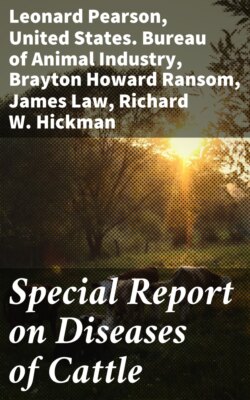Читать книгу Special Report on Diseases of Cattle - Lowe - Страница 108
На сайте Литреса книга снята с продажи.
PERICARDITIS.
ОглавлениеInflammation of the pericardium (heart bag) is often associated with pneumonia and pleurisy, rheumatism, and other constitutional diseases, or with an injury. It also occurs as an independent affection, owing to causes similar to those of other chest affections, as exposure to cold or dampness and changes of the weather.
Symptoms.—It may be ushered in with a chill, followed by fever, of more or less severity; the animal stands still and dull, with head hanging low, and anxiety expressed in its countenance. The pulse may be large, perhaps hard; there is also a venous pulse. The hand against the chest will feel the beating of the heart, which is often irregular, sometimes violent, and in other instances weak, depending in part upon the quantity of fluid that has transuded into the pericardial sac. The legs are cold, the breathing quickened and usually abdominal; if the left side of the chest is pressed on or struck, the animal evinces pain. There may be spasms of the muscles in the region of the breast, neck, or hind legs. After a variable time swelling may also appear in the legs and under the chest and brisket.
In those animals in which the heart sounds may be heard somewhat distinctly, the ear applied against the chest will detect a to-and-fro friction sound, corresponding to the beats of the heart. This sound is produced by the rubbing of the internal surface of the heart bag against the external surface of the heart. During the first stages of the inflammation these surfaces are dry, and the rubbing of one against the other during the contraction and relaxation of the heart produces this sound. The dry stage is followed by the exudation of fluid into the heart sac, and the friction is not heard until the fluid is absorbed sufficiently to allow the surfaces to come in contact again. But during the time the friction sound is lost a sound which has been called a "churning noise" may take its place.
The friction sound of pericarditis can not be mistaken for the friction sound of pleurisy if the examination is a careful one, because in the heart affection the sound is made in connection with the heart beats, while in the pleuritic affection the sound is synchronous with each respiration or breath of air taken in and expelled from the lungs.
Treatment.—When pericarditis is complicated with rheumatism or other diseases the latter must be treated as directed in the description of them. The animal must be kept in a quiet, comfortable place, where it will be free from excitement. Warm clothing should be applied to the body, and the legs should be hand-rubbed until the circulation in them is reestablished, and then they should be snugly bandaged. The food should be nutritive and in moderate quantity. Bleeding should not be performed unless the case is in the hands of an expert.
At the beginning give as a purgative Epsom salt—1 pound to an average-sized cow—dissolved in about a quart of warm water and administered as a drench. When there is much pain 2 ounces of laudanum, diluted with a pint of water, may be given every three hours until the animal is better. Do not give the laudanum unless demanded by the severity of the pain, as it tends to constipate. Give one-half ounce of nitrate of potassium (saltpeter), dissolved in drinking water, four or five times a day. After the attack has abated mustard mixed with water may be rubbed well over the left side of the chest to stimulate the absorption of the fluid within the pericardium. The other medicines may be discontinued and the following administered: Sulphate of iron, 2 ounces; powdered gentian, 6 ounces; mix and make 8 powders. Give one powder every day at noon, mixed with feed, if the animal will eat it, or shaken up with water in a bottle as a drench. Also the following: Iodid of potassium, 2 ounces; nitrate of potassium, 8 ounces; mix and make 16 powders. Give one in drinking water or in drench every morning and evening. The last two prescriptions may be continued for several weeks if necessary.
In extreme cases tapping the pericardium with a trocar and cannula to draw off the fluid is resorted to, but the operation requires exact anatomical knowledge.
After death from pericarditis there is always more or less fluid found in the pericardium; the surfaces are rough and covered with a yellow-colored exudate. There are also in many cases adhesions to a greater or less extent between the heart and pericardium.
